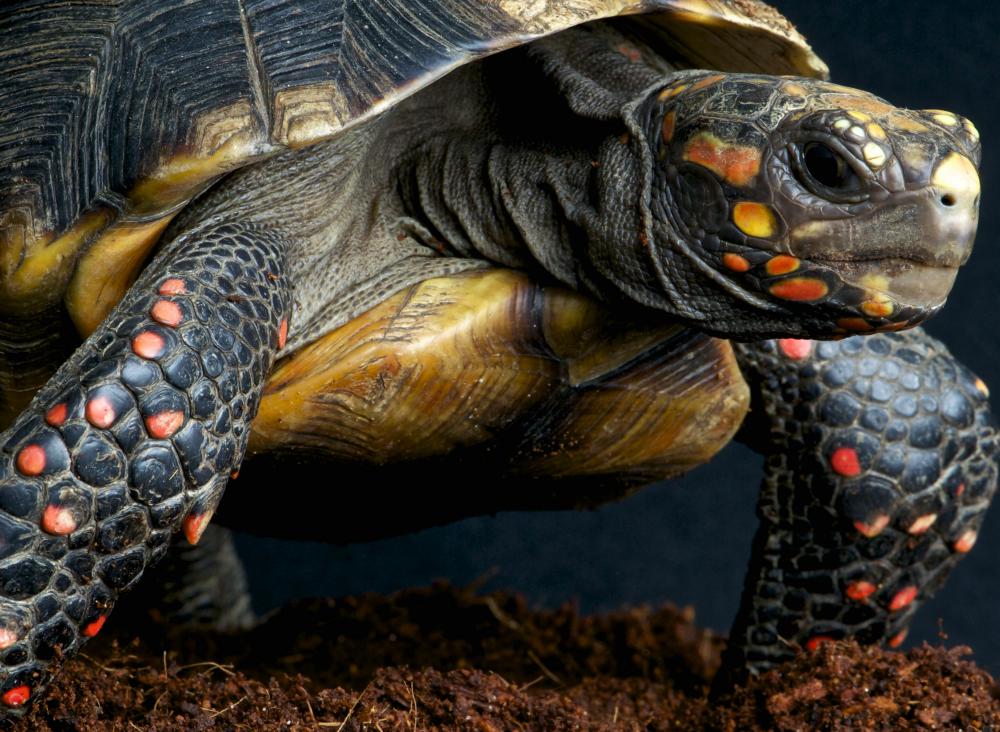At AllThingsNature, we're committed to delivering accurate, trustworthy information. Our expert-authored content is rigorously fact-checked and sourced from credible authorities. Discover how we uphold the highest standards in providing you with reliable knowledge.
What Is a Texas Tortoise?
The Texas tortoise or Gopherus berlandieri is the smallest of the four tortoise species native to North America. They are found throughout Texas and in the northern provinces of Coahuila, Nuevo Leon, and Tamaulipas in Mexico. It is illegal to have one without a permit as they are on the threatened species list of Texas Parks and Wildlife.
The shell of the Texas tortoise has yellowy-orange plates and the male can be differentiated from the female by the fact that the underside of his shell is slightly concave. The female, on the other hand, has a flat underbelly and is usually slightly smaller in size. The concave nature of the male's shell allows for easier mounting during reproduction. The Texas tortoise usually grows to between eight and nine inches (20.32 to 22.86 cm) in length.

The male Texas tortoise is usually territorial and may fight another male who enters his space. They have a forked projection at the front of their underbelly shell which is used in these fights. Attempts are often made to turn the opponent onto their back, a position from which they may not be able to recover. In the desert conditions that they live in this can result in death by overheating.

A pallet, or depression in the ground, dug by the Texas tortoise, is where it spends most of its time. Other tortoises dig burrows into the ground but the Texas tortoise prefers to remain above ground. During summer, they remain in their pallet in the heat of the day and then wander about during cooler periods. Depending on the climate in which they are living, they may hibernate during the cold winter months. It is not unusual, however, for them to become active during warm spells in winter.
As with all tortoises, the Texas tortoise is a herbivore, or vegetarian. They feed mainly on grasses, weeds and succulent plants such as the prickly pear. These succulent plants provide most of their water, too, as in the arid areas they live in, water can be hard to come by. Slow-moving by nature, they do not move large distances.
Due to their threatened existence, it is illegal to remove a Texas tortoise from its natural habitat. Some tortoise breeders do breed them but they require special care and handling. If they are kept under the wrong conditions, they will die. Should a person wish to keep a tortoise as a pet, expert advice should be sought regarding their very specific needs.
Frequently Asked Questions
What is a Texas Tortoise?
The Texas Tortoise, scientifically known as Gopherus berlandieri, is a species of tortoise native to the southern United States, particularly Texas. It is a small, terrestrial reptile, recognized by its brown or grayish-brown carapace and elephantine hind legs. This tortoise prefers arid and semiarid habitats with sandy soil where it can burrow.
How big does a Texas Tortoise get?
Adult Texas Tortoises typically reach a carapace length of about 8 to 11 inches. They are considered relatively small compared to other tortoise species. Their size is an adaptation to the hot, dry environments they inhabit, allowing them to efficiently manage their body temperature and water retention.
What does the Texas Tortoise eat?
The Texas Tortoise is primarily herbivorous, feeding on a variety of native grasses, cacti, and succulents. They also consume fruits and vegetables when available. Their diet is high in fiber and water content, which is crucial for their digestion and hydration in the arid habitats they occupy.
Is the Texas Tortoise an endangered species?
As of my knowledge cutoff in 2023, the Texas Tortoise is listed as a threatened species under the Texas Parks and Wildlife Code. Habitat loss, road mortality, and collection for the pet trade have all contributed to its decline. Conservation efforts are in place to protect this species and its habitat.
How long do Texas Tortoises live?
Texas Tortoises can have a long lifespan, often living for more than 50 years in the wild. In captivity, with proper care, they may live even longer. Their longevity is attributed to their slow metabolism and protective shell, which shields them from many natural predators.
Can I keep a Texas Tortoise as a pet?
While Texas Tortoises may seem like suitable pets, it is illegal to collect, possess, or transport them without a permit in Texas due to their threatened status. It is important to respect wildlife laws and opt for captive-bred tortoises of non-threatened species if you are interested in keeping a tortoise as a pet.
AS FEATURED ON:
AS FEATURED ON:












Discuss this Article
Post your comments